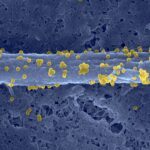Lien vers Pubmed [PMID] – 23691172
PLoS ONE 2013;8(5):e64219
Optimizing therapeutic strategies for an HIV cure requires better understanding the characteristics of early HIV-1 spread among resting CD4+ cells within the first month of primary HIV-1 infection (PHI). We studied the immune distribution, diversity, and inducibility of total HIV-DNA among the following cell subsets: monocytes, peripheral blood activated and resting CD4 T cells, long-lived (naive [TN] and central-memory [TCM]) and short-lived (transitional-memory [TTM] and effector-memory cells [TEM]) resting CD4+T cells from 12 acutely-infected individuals recruited at a median 36 days from infection. Cells were sorted for total HIV-DNA quantification, phylogenetic analysis and inducibility, all studied in relation to activation status and cell signaling. One month post-infection, a single CCR5-restricted viral cluster was massively distributed in all resting CD4+ subsets from 88% subjects, while one subject showed a slight diversity. High levels of total HIV-DNA were measured among TN (median 3.4 log copies/million cells), although 10-fold less (p = 0.0005) than in equally infected TCM (4.5), TTM (4.7) and TEM (4.6) cells. CD3-CD4+ monocytes harbored a low viral burden (median 2.3 log copies/million cells), unlike equally infected resting and activated CD4+ T cells (4.5 log copies/million cells). The skewed repartition of resting CD4 subsets influenced their contribution to the pool of resting infected CD4+T cells, two thirds of which consisted of short-lived TTM and TEM subsets, whereas long-lived TN and TCM subsets contributed the balance. Each resting CD4 subset produced HIV in vitro after stimulation with anti-CD3/anti-CD28+IL-2 with kinetics and magnitude varying according to subset differentiation, while IL-7 preferentially induced virus production from long-lived resting TN cells. In conclusion, within a month of infection, a clonal HIV-1 cluster is massively distributed among resting CD4 T-cell subsets with a flexible inducibility, suggesting that subset activation and skewed immune homeostasis determine the conditions of viral dissemination and early establishment of the HIV reservoir.

